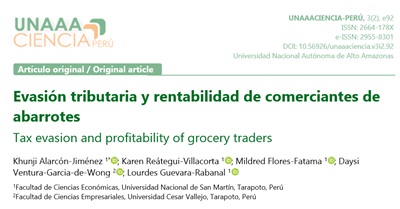Tax evasion and profitability of grocery traders
DOI:
https://doi.org/10.56926/unaaaciencia.v3i2.92Keywords:
informality, tax compliance, commercial profitability, tax audit, sustainable taxationAbstract
Tax evasion is a recurrent problem in the commercial sector, affecting tax collection and business sustainability. The objective of the study was to determine the relationship between tax evasion and the profitability of grocery traders in a local market in Peru. The research adopted a quantitative, descriptive-correlational approach, with a sample of 88 traders, selected by simple random sampling. A structured questionnaire was applied and the data were analyzed with statistical tests, including the Chi-square test (X²C = 8.132; p < 0.05). The results showed that 36% of the traders are not registered in any tax regime, and that 55% of those who evade taxes have low profitability. It was also identified that the lack of tax education and distrust in the tax administration are key factors in tax evasion. It is concluded that tax evasion has a negative impact on profitability, limiting access to financing and business expansion.
Downloads
References
Alm, J. (2021). Tax evasion, technology, and inequality. Economics of Governance, 22(4), 321–343. https://doi.org/10.1007/s10101-021-00247-w DOI: https://doi.org/10.1007/s10101-021-00247-w
Alm, J., & Malézieux, A. (2021). 40 years of tax evasion games: a meta-analysis. Experimental Economics, 24(3), 699–750. https://doi.org/10.1007/s10683-020-09679-3 DOI: https://doi.org/10.1007/s10683-020-09679-3
Amalia, R. F., & Fikri, H. (2023). Tax Legal Perspective on Digital Assets Trading Transactions in Metaverse (pp. 334–342). https://doi.org/10.2991/978-94-6463-140-1_33 DOI: https://doi.org/10.2991/978-94-6463-140-1_33
Astuti, A., Pricilia, M. D., & Inasius, F. (2024). Factors influencing tax compliance among e-commerce traders in Indonesia. Macroeconomics and Finance in Emerging Market Economies, 1–18. https://doi.org/10.1080/17520843.2024.2429909 DOI: https://doi.org/10.1080/17520843.2024.2429909
Ermasova, N., Haumann, C., & Burke, L. (2021). The Relationship between Culture and Tax Evasion across Countries: Cases of the USA and Germany. International Journal of Public Administration, 44(2), 115–131. https://doi.org/10.1080/01900692.2019.1672181 DOI: https://doi.org/10.1080/01900692.2019.1672181
Fernández-Bastidas, R. (2023). Entrepreneurship and tax evasion. Economic Modelling, 128, 106488. https://doi.org/10.1016/j.econmod.2023.106488 DOI: https://doi.org/10.1016/j.econmod.2023.106488
Flores García, I. E. (2019). Causas de la evasión tributaria en los comerciantes de abarrotes del Mercado Modelo de Huancayo en el año 2016 [Universidad Continental]. https://repositorio.continental.edu.pe/handle/20.500.12394/5137
Grym, J., Aspara, J., Nandy, M., & Lodh, S. (2024). A Crime by Any Other Name: Gender Differences in Moral Reasoning When Judging the Tax Evasion of Cryptocurrency Traders. Behavioral Sciences, 14(3), 198. https://doi.org/10.3390/bs14030198 DOI: https://doi.org/10.3390/bs14030198
López‐Laborda, J., Vallés‐Giménez, J., & Zarate‐Marco, A. (2023). Fighting vacation rental tax evasion through warnings to potential evaders. Real Estate Economics, 1–30. https://doi.org/10.1111/1540-6229.12425 DOI: https://doi.org/10.1111/1540-6229.12425
Mengistu, A. T., Molla, K. G., & Mascagni, G. (2022). Trade Tax Evasion and the Tax Rate: Evidence from Transaction-level Trade Data. Journal of African Economies, 31(1), 94–122. https://doi.org/10.1093/jae/ejab005 DOI: https://doi.org/10.1093/jae/ejab005
Morales Tostado, M. del C., Echeverría Rodríguez, L. G., Huerta Urquijo, B. E., & Quinto Lorenzo, E. L. (2019). Cultura Tributaria en Hermosillo, Sonora, México. BIOLEX REVISTA JURIDICA DEL DEPARTAMENTO DE DERECHO, 11(21), 63–80. https://doi.org/10.36796/biolex.v21i0.157 DOI: https://doi.org/10.36796/biolex.v21i0.157
Paredes Floril, P. R. (2015). La evasión tributaria e incidencia en la recaudación del impuesto a la renta de personas naturales en la provincia del Guayas, período 2009-2012. [Universidad de Guayaquil]. http://repositorio.ug.edu.ec/handle/redug/6881
Payne, J. E., & Saunoris, J. W. (2020). Corruption and Firm Tax Evasion in Transition Economies: Results from Censored Quantile Instrumental Variables Estimation. Atlantic Economic Journal, 48(2), 195–206. https://doi.org/10.1007/s11293-020-09666-2 DOI: https://doi.org/10.1007/s11293-020-09666-2
Peña Ramírez, M. P., & Núñez Gonsález, C. (2021). Cultura tributaria y el cumplimiento de las obligaciones tributarias, en el sector comercio de Pucallpa, Perú. Revista Hechos Contables, 1(2), 51–62. https://doi.org/10.52936/rhc.v1i2.76 DOI: https://doi.org/10.52936/rhc.v1i2.76
Ridwansyah, R., & Indayani. (2024). The Effect of Profitability, Debt Policy, Political Connections, Economic Crisis on Tax Aggressiveness. International Journal of Economics (IJEC), 3(1), 211–221. https://doi.org/10.55299/ijec.v3i1.718 DOI: https://doi.org/10.55299/ijec.v3i1.718
Rivera Presentacion, J. J. (2022). Evasión tributaria y su relación con la recaudación fiscal en el sector hotelero del distrito de Amarilis, Huánuco, periodo 2020 - 2021 [Universidad de Huánuco]. http://repositorio.udh.edu.pe/handle/123456789/3280
Stevanie, S., Siburian, M. E., & Sitepu, W. R. B. (2023). Can Firm Size Moderate a Company’s Tax Avoidance in Retail Trading? Oblik i Finansi, 4(102), 72–80. https://doi.org/10.33146/2307-9878-2023-4(102)-72-80 DOI: https://doi.org/10.33146/2307-9878-2023-4(102)-72-80
Wahdi, N., Astuti, W., & Assih, P. (2024). The Influence of Corporate Social Responsibility and Profitability on Tax Avoidance. Innovation Business Management and Accounting Journal, 3(1), 30–36. https://doi.org/10.56070/ibmaj.2024.004 DOI: https://doi.org/10.56070/ibmaj.2024.004

Downloads
Published
How to Cite
Issue
Section
License
Copyright (c) 2024 Khunji Alarcón-Jiménez, Karen Reátegui-Villacorta, Mildred Flores-Fatama, Daysi Ventura-Garcia-de-Wong, Lourdes Guevara-Rabanal

This work is licensed under a Creative Commons Attribution 4.0 International License.
The authors retain their rights:
a. The authors retain their trademark and patent rights, as well as any process or procedure described in the article.
b. The authors retain the right to share, copy, distribute, execute and publicly communicate the article published in the scientific journal UNAAACIENCIA-PERÚ (for example, place it in an institutional repository or publish it in a book), with an acknowledgment of its initial publication in UNAAACIENCIA-PERU.
c. Authors retain the right to make a subsequent publication of their work, to use the article or any part of it (for example: a compilation of their works, notes for conferences, thesis, or for a book), provided that they indicate the source. of publication (authors of the work, magazine, volume, number and date).







